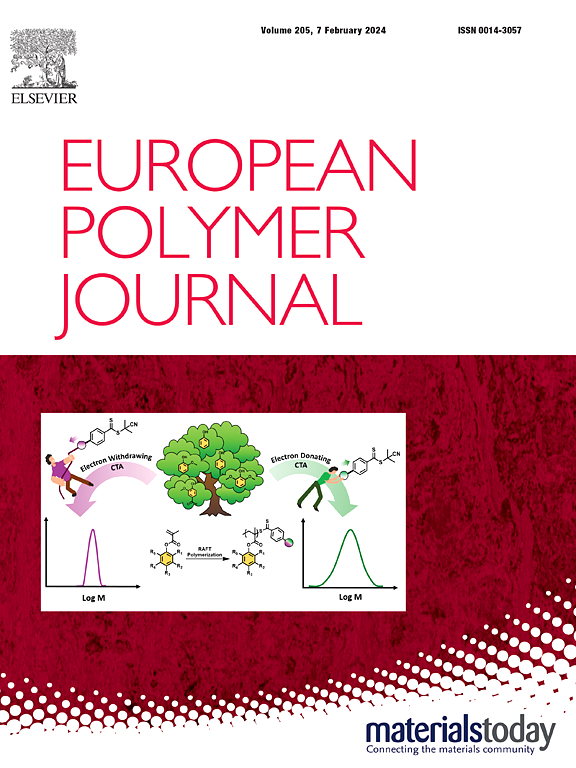A CFRP recycling strategy of integrating catalytic hydrolysis and catalyst-involved high-value reutilization of degradation products
IF 5.8
2区 化学
Q1 POLYMER SCIENCE
引用次数: 0
Abstract
The escalating accumulation of carbon fiber-reinforced polymer (CFRP) waste and the limitations of conventional recycling methods demand innovative strategies to achieve full-component recovery and sustainable valorization. CFRP waste is hard to recycle because of its dense physical/chemical structure and solvent resistance, especially in aqueous solvent degradation systems. Here, we report a CFRP recycling strategy that integrates catalytic hydrolysis and high-value reuse of degradation products. The FeCl3 catalytic system enables efficient hydrolysis and slightly oxidative degradation of the epoxy thermosets in CFRP. High-performance adhesives can be produced through the supramolecular interactions between iron ions and degradation products without the need of separation process. Simultaneously, carbon fibers (CFs) are recovered with minimal surface damage. This strategy not only addresses CFRP waste management challenges but also converts both polymer matrix and catalyst residues into value-added materials, offering a scalable and eco-friendly solution for circular composites economy.

整合催化水解和催化降解产物高价值再利用的CFRP回收策略
碳纤维增强聚合物(CFRP)废物的不断积累和传统回收方法的局限性要求创新策略来实现全组分回收和可持续增值。CFRP废料由于其致密的物理/化学结构和耐溶剂性而难以回收,特别是在水溶剂降解体系中。在这里,我们报告了一种CFRP回收策略,该策略集成了催化水解和降解产物的高价值再利用。FeCl3催化系统能够有效水解和轻微氧化降解CFRP中的环氧热固性树脂。通过铁离子与降解产物之间的超分子相互作用,无需分离过程即可制备高性能胶粘剂。同时,碳纤维(CFs)的表面损伤最小。该策略不仅解决了CFRP废弃物管理的挑战,还将聚合物基质和催化剂残留物转化为增值材料,为循环复合材料经济提供了可扩展和环保的解决方案。
本文章由计算机程序翻译,如有差异,请以英文原文为准。
求助全文
约1分钟内获得全文
求助全文
来源期刊

European Polymer Journal
化学-高分子科学
CiteScore
9.90
自引率
10.00%
发文量
691
审稿时长
23 days
期刊介绍:
European Polymer Journal is dedicated to publishing work on fundamental and applied polymer chemistry and macromolecular materials. The journal covers all aspects of polymer synthesis, including polymerization mechanisms and chemical functional transformations, with a focus on novel polymers and the relationships between molecular structure and polymer properties. In addition, we welcome submissions on bio-based or renewable polymers, stimuli-responsive systems and polymer bio-hybrids. European Polymer Journal also publishes research on the biomedical application of polymers, including drug delivery and regenerative medicine. The main scope is covered but not limited to the following core research areas:
Polymer synthesis and functionalization
• Novel synthetic routes for polymerization, functional modification, controlled/living polymerization and precision polymers.
Stimuli-responsive polymers
• Including shape memory and self-healing polymers.
Supramolecular polymers and self-assembly
• Molecular recognition and higher order polymer structures.
Renewable and sustainable polymers
• Bio-based, biodegradable and anti-microbial polymers and polymeric bio-nanocomposites.
Polymers at interfaces and surfaces
• Chemistry and engineering of surfaces with biological relevance, including patterning, antifouling polymers and polymers for membrane applications.
Biomedical applications and nanomedicine
• Polymers for regenerative medicine, drug delivery molecular release and gene therapy
The scope of European Polymer Journal no longer includes Polymer Physics.
 求助内容:
求助内容: 应助结果提醒方式:
应助结果提醒方式:


